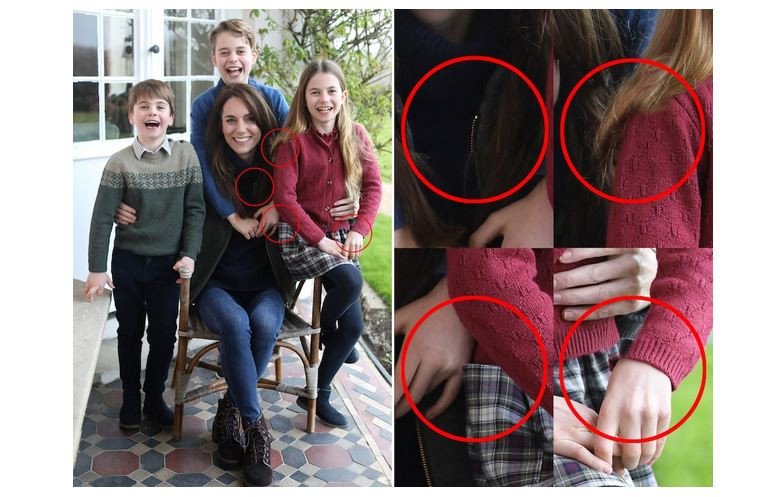By removing the royal photos from circulation, news agencies have sent Kensington Palace a serious message about their commitment to transparency and accuracy
THE Paul Clarkeveteran photographer, rowed on the River Thames, when his phone started ringing non-stop. The royal family had just released a photo of themselves Kate Middleton, Princess of Wales, and her three children, however, something was wrong.
Clarke is an expert in the art of editing and photo retouching and friends wanted his opinion on the picture. He quickly noticed that the image was “teased”.
What was going on with Princess Charlotte’s hand, which looked distorted by her sleeve? Why were her mother’s fingers so blurry? The photo, Clarke noted in a social media post that quickly went viral, it contained “numerous … falsifications that are easily visible.”
At the risk of drawing too much attention to things which perhaps don’t deserve it, there are numerous 100%-certain photographic manipulations easily visible on that Kate photo. What *were* they thinking? #cuffgate pic.twitter.com/JHrvwSCkrK
— Paul Clarke (@paul_clarke) March 10, 2024
Within hours, the major news outlets that had released the Palace photos—companies such as Getty Images, Agence France-Presse and the Associated Press—asked their clients to stop using them over concerns that the image had “ harassed’ in violation of their ethical rules. And on Monday, Kate Middleton apologized: “Like many amateur photographers,” he explained in an official statement, he had “experimented with editing.”
View this post on InstagramA post shared by The Prince and Princess of Wales (@princeandprincessofwales)
The incident also highlighted the pathogens of the media. On the one hand, we have the ever-increasing expectations of celebrity perfection—smooth faces and cellulite-free thighs, best achieved with a little Photoshop. On the other hand, journalistic integrity and transparency have gone for a walk as AI deepfakes and cries of “fake news” have permeated the culture.
It also raised questions about the ability of the Palace “people” to protect Kate Middleton. Because it is considered almost certain that all this development brought the opposite results.
“What were they thinking?” wondered Sally Bedell Smith, a royal biographer. “This particular photo creates a rather large credibility problem.”
But Clarke, who sees no conspiracy (just incompetence), thinks the question of credibility is misplaced. Why wouldn’t the royal family want to fix an image? “We all want pictures of our children smiling.”
The question, he said, is whether the media were too quick to pass it on to the public — too willing, in other words, to present an overly pretty picture as news.
Celebrities aspire to look perfect. Journalism aspires to tell the truth. But those standards clashed when Kensington Palace released its first photo of Catherine since her surgery, with obvious manipulations that may have exacerbated a royal PR crisis. https://t.co/KQ2U82f5DX
— The Washington Post (@washingtonpost) March 11, 2024
Journalistic ethics require that images published in news agencies depict reality, without post-processing such as Photoshop or other editing software. The images from the war in Ukraine, for example, have been analyzed pixel by pixel for elements of potential misinformation.
But in the VIP field, where the kings reside, Photoshop isn’t just accepted, it’s expected.
Fashion magazines and celebrity-focused publications are not held to the same standards with news agencies regarding photographs, often retouching their cover and profile subjects, in service of selling an aspirational lifestyle.
Today, our phones and computers offer similar technologyaccessible to the average Facebook user who just wants a more flattering profile picture.
This is the very human “misdemeanor” the princess confessed to and a palace expert characterized it as “an innocent, naive mistake” which the public will quickly forgive.
Susan Keith, professor of journalism and media studies at Rutgers University, reported on the issue. “By removing the royal photos from circulation, news agencies have sent Kensington Palace a serious message about their commitment to transparency and accuracy.”
Source :Skai
I am Frederick Tuttle, who works in 247 News Agency as an author and mostly cover entertainment news. I have worked in this industry for 10 years and have gained a lot of experience. I am a very hard worker and always strive to get the best out of my work. I am also very passionate about my work and always try to keep up with the latest news and trends.











